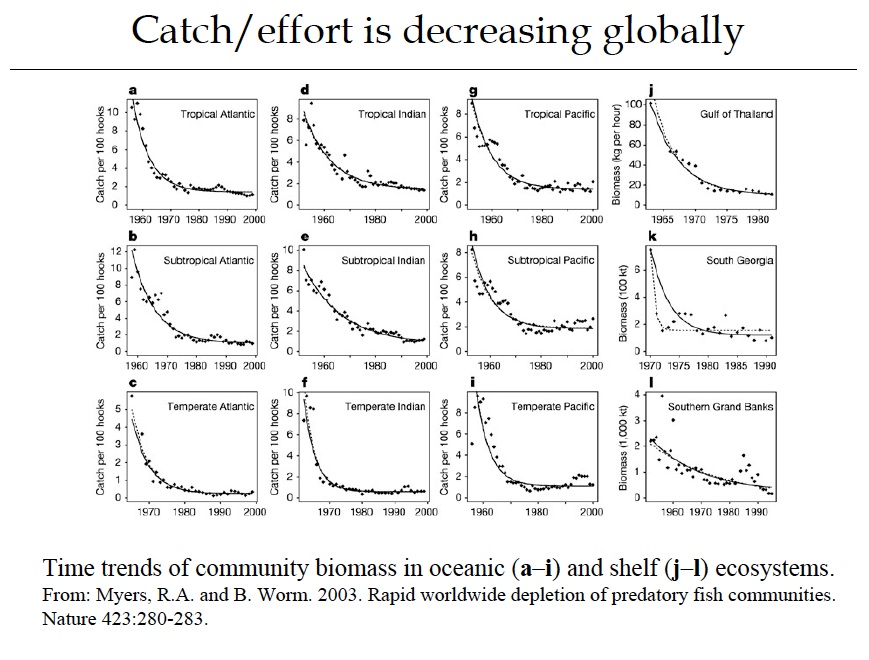"stock" is typically a very general (non-rigorous) term used to describe a regional population that is isolated from other conspecific populations during some period of life historyDefining a stock: geographic range, age/size distribution, life history variables
Recognizing stocks is important for understanding their health and management
Tags, molecular markers, otoliths, and census techniques may all help quantify fish stocksLandings (number of fish harvested) are influenced by fishing effort (number of fishermen and number of hours spent fishing)
Catch/unit effort measures generally provide the best estimates of stock sizeLandings are useful for managing harvest levels when stocks become over exploited, but they often do not help with "healthy" stocks.
Quotas vs "Seasons" for managing when fishermen can and can't fish.
Models of "Maximum Sustainable Yield" are often used to predict maximum harvest rates
Here is a good review of the challenge and approaches of stock assessment
Lack of data on stock size, demography, etc., combined with low levels of enforcement generally leads to severe over exploitation.
Capture methods commonly include hooks, nets, and traps.
Gill nets, pound nets, and seine nets either entangle fish or surround them with netsOpen ocean drift nets up to 30 miles long are sometimes released to capture squid and fishLong line sets may be 20-80 miles long, with many thousands of hooks
When used intensively, long lines can be very effective:US harvest of yellowfin tuna in the Gulf of Mexico in 1984: 35,000 lb.. In 1988: 12 million lb..
Cyanide sulfate and dynamite are often used to collect fish from coral reefs for food and the aquarium trade.
As a general rule, the most efficient harvesting methods are also the least selective and, thus, the most wasteful
"By-catch" describes the organisms that are captured, but discarded.... these are often smaller fish and invertebrates, but can include turtles, sharks, bill fish, and whalesTotal global by-catch is currently estimated to be about 27 million metric tons per annum.Shrimp trawling generates high levels of by-catch: 2-8 lb./1 lb. of shrimp
By-catch levels are highest in the western Pacific: 9 million metric tons/year
Most exploitable marine fisheries are characterized by cycles of boom and bust.
Aspects of supply and demand suggest a reduction in harvest levels as species become rare...
Even when stocks are severely depleted, economics can drive species closer to extinction. Three case histories:
Bluefin tunaBluefin tuna were originally considered trash fish... in 1934 they were sometimes collected for their livers and fish sold for ~ $0.15/lb.As traditionally harvested fish stocks and other species of tuna became more rare, bluefin became commercially profitable
Today, blue fin tuna are prized for sushi and auctioned at special fish markets.
Japanese bidders can drive prices very high for fish of high quality:
In 1995, a 715 lb. bluefin tuna was sold for $83,500 (~$117/lb.).
This fish produced ~ 2,400 sushi meals worth $75: total final worth of fish: ~ $180,000
The trend of increasing value continues (Jan, 2011), a 752 lb. bluefin tuna was sold for $396,000 (~$526/lb.).
This translates to ~ 2525 sushi meals, worth ~ $190,000
In 2012, a 593 lb fish garnered $736,000
In 2013, a 489 lb fish was sold for $1.76 million, though the buyer admitted this was an advertising stunt as much as anything and since then, the madness has abated some (2014: $70,000 for a 507 lb tuna; 2015: $37,500 for a 400 lb fish).
With such demand, fishermen employ planes and electronic harpoons to track down a single fish.
There is little short-term incentive to conserve... Japanese corporations such as Mitsubishi are stockpiling frozen tuna, so they can corner the market once natural populations are depleted near or to extinction.
There are still big fish out there... a record 827 lb fish was caught in 2017, and an 800 lb tuna was caught in 2015 (though it was confiscated by NOAA agents because the skipper did not have permits to catch it. Not that that helps the fish, but it may prevent other fishermen from setting nets that might catch tuna accidentally).
Sharks, once considered a menace to humans, are rapidly disappearing from our oceans
Today, sharks are harvested for meat, skin, cartilage, and finsShark fins are prized by Asian markets for their use in soups (they add no flavor, only texture).They sell for up to $200/lb.
Many shark fins come from US waters.
Only 3 of 26 countries with shark fisheries have any management or research programs.
With long gestation periods and small clutch sizes shark populations do not rebound rapidly
Whales were targeted primarily for their oil until WW II... then they were used for pet food.
The advent of factory ships that processed whales greatly increased the rate of harvest.Seasonal regulations were imposed in 1937, however, no limit was placed on how many whales could be killed, and the number of vessels hunting whales increased.
Species such as blue whales declined rapidly for several decades, and by the time hunting was banned in the 60s, they were already too rare to harvest commercially.
Japan continues to do limited whaling for "research" purposes.
Essentially, these uncontrolled or excessive levels of exploitation mean that populations are declining.
For fish:

Mariculture: mythical cure or salvation for over harvested fisheries?
Mariculture practices seek to rear marine organisms under controlled environmental conditions.Given high levels of fecundity and low levels of recruitment, many mariculture attempts focus on juveniles
Providing substrate can promote settlement (e.g. mussels and oysters), however, local abundances of certain species can deplete local resources or produce high levels of organic waste.
Most mariculture attempts have failed to prove economically feasible. Rearing of salmon in pens is becoming more popular as wild stocks continue to decline.
Disease, escapees, and the inefficiency of fish farming (it takes 5 kg of anchovies to produce 1 kg of farmed salmon)... remember the 20% trophic biomass conversion for ectotherms.